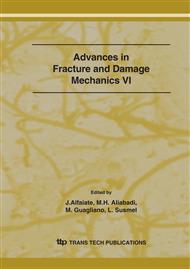p.757
p.761
p.765
p.769
p.773
p.777
p.781
p.785
p.789
An Experimental Study on the Influence of Steel Rod Corrosion in Concrete Cracks
Abstract:
The purpose of this study is to define the amount of critical corrosion in steel that causes cracks on the cover of concrete. Major variables in the amount of critical corrosion are concrete strength, thickness, and the cover of concrete. In this experiment, stress concentration is a newly added factor. According to the results of this experiment, it is evident that the amount of critical corrosion decreased according to the increase in stress concentration factors. In addition, electric currents were measured using a constant voltage generator. When a constant voltage was connected to the corrosion circuits, it was discovered that the magnitude in the change was similar to the displacement on the cover of concrete and the electric current according to time.1)
Info:
Periodical:
Pages:
773-776
Citation:
Online since:
September 2007
Authors:
Price:
Сopyright:
© 2007 Trans Tech Publications Ltd. All Rights Reserved
Share:
Citation:


